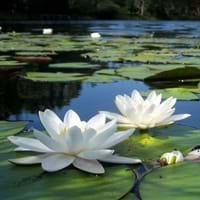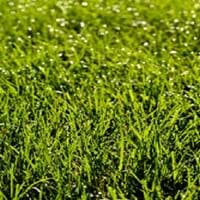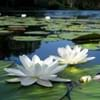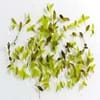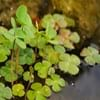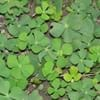Life Span
Perennial
Perennial
Type
Aquatics, Flowering Plants
Grass
Origin
Not Available
Southern Asia, India
Types
Not Available
Not Available
Number of Varieties
Not Available
Habitat
Ponds
Warmer regions
USDA Hardiness Zone
4-11
6-11
AHS Heat Zone
Not Available
11- 6
Sunset Zone
Not Available
H1, H2, 5, 6, 7, 8, 9, 10, 12, 13, 14, 15, 16, 17, 18, 19, 20, 21, 22, 23, 24
Habit
Spreading
Mat-forming
Flower Color
White
Not Available
Flower Color Modifier
Bicolor
Bicolor
Fruit Color
Non Fruiting Plant
Not Available
Leaf Color in Spring
Light Green
Gray Green, Dark Green
Leaf Color in Summer
Light Green
Light Green
Leaf Color in Fall
Green
Gray Green, Dark Green
Leaf Color in Winter
Green
Gray Green, Dark Green, Tan
Leaf Shape
Round
Arrowhead
Plant Season
Early Summer, Late Summer
Spring, Summer, Fall, Winter
Sunlight
Partial Sun
Full Sun
Type of Soil
Aquatic Plant
Clay, Loam, Sand
The pH of Soil
Aquatic Plant
Acidic, Neutral, Alkaline
Soil Drainage
Average
Well drained
Bloom Time
Early Summer, Late Summer
Indeterminate
Tolerances
waterlogging
Pollution, Salt, Soil Compaction
Where to Plant?
In Water
Container, Ground
How to Plant?
Stem Planting
Seedlings
Plant Maintenance
Medium
Medium
Watering Requirements
Plant grows in water
Average Water Needs
In Summer
Aquatic Plant
Lots of watering
In Spring
Aquatic Plant
Moderate
In Winter
Aquatic Plant
Average Water
Soil pH
Aquatic Plant
Acidic, Neutral, Alkaline
Soil Type
Not Applicable
Clay, Loam, Sand
Soil Drainage Capacity
Aquatic Plant
Well drained
Sun Exposure
Partial Sun
Full Sun
Pruning
No need to prune
No pruning needed
Fertilizers
Fertilize the first year
Apply 3-1-2 or 4-1-2 ratio, Nitrogen
Pests and Diseases
Leaf eating pests, Sap-Sucking Insects, Stem rot
Red blotch
Plant Tolerance
waterlogging
Pollution, Salt, Soil Compaction
Flowers
Showy
Insignificant
Flower Petal Number
Single
Single
Foliage Texture
Fine
Fine
Foliage Sheen
Matte
Matte
Attracts
Fishes
Flying insects, Insects
Allergy
Not Available
breathing problems, Eye irritation, Hives, Itchiness, Runny nose, sneezing, Throat itching, Whooping Cough
Aesthetic Uses
Showy Purposes, Water gardening
Ground Cover, Landscape Designing
Beauty Benefits
Good for skin, Moisturizing, Weightloss
Skin irritation, Skin Problems
Edible Uses
Yes
Insignificant
Environmental Uses
Not Available
Air purification, Prevent Soil Erosion, soil stabilisation
Medicinal Uses
Antibacterial, Anti-fungal, anti-inflammatory, Antioxidants, Astringent, Clears heat, Combats Stress, Detoxification, Diabetes, High cholestrol, Improve heart health, Liver problems, Low Blood Pressure, Phosphorus, Rich in Iron, Vitamin B, Vitamin C
Cures constipation, Cures foot fissures, Digestive disorders, Eliminate toxins, Fatigue, Halitosis, Improves Breast milk production, Increase red blood cells, Insomnia
Part of Plant Used
Leaves, Root, Stem
Leaves, Stem
Other Uses
Can be made into a herbal tea, Culinary use, Used as Ornamental plant, Used in herbal medicines
Animal Feed, Cattle Fodder, Used as Ornamental plant
Used As Indoor Plant
Yes
Insignificant
Used As Outdoor Plant
Yes
Yes
Garden Design
Bog Garden, Water Gardens
Lawns and Turf
Botanical Name
Nymphaea lotus
CYNODON dactylon
Common Name
white Egyptian lotus, tiger lotus, white lotus or Egyptian white water-lily
Bermuda Grass
In Hindi
सफेद कमल
बरमूडा घास
In German
Tigerlotus
Bermuda Gras
In French
Lotier d'Égypte, Lotus tigré
l'herbe des Bermudes
In Spanish
loto tigre, nenúfar blanco egipcio
Grama
In Greek
λευκό λωτού
Αγριάδα
In Portuguese
nenúfar-branco, lótus-branco, lótus-do-egipto, loto-sagrado-do-egito e lótus-sagrado-do-egito
grama Bermuda
In Polish
białego lotosu
Trawa Bermuda
In Latin
albus Lotus
Bermuda Grass
Phylum
Magnoliophyta
Magnoliophyta
Class
Magnoliopsida
Liliopsida
Order
Nymphaeales
Cyperales
Family
Nymphaeaceae
Poaceae
Genus
Nymphaea
Cynodon Rich
Clade
Angiosperms
Angiosperms, Commelinids
Tribe
Not Available
Chlorideae
Subfamily
Not Available
Chloridoideae
Number of Species
Not Available
Importance of White Lotus and Bermuda Grass
Want to have the most appropriate plant for your garden? You might want to know the importance of White Lotus and Bermuda Grass. Basically, these two plants vary in many aspects. Compare White Lotus and Bermuda Grass as they differ in many characteristics such as their life, care, benefits, facts, etc. Every gardener must at least have the slightest clue about the plants he wants to plant in his garden. Compare their benefits, which differ in many ways like facts and uses. The medicinal use of White Lotus is Antibacterial, Anti-fungal, anti-inflammatory, Antioxidants, Astringent, Clears heat, Combats Stress, Detoxification, Diabetes, High cholestrol, Improve heart health, Liver problems, Low Blood Pressure, Phosphorus, Rich in Iron, Vitamin B and Vitamin C whereas of Bermuda Grass is Cures constipation, Cures foot fissures, Digestive disorders, Eliminate toxins, Fatigue, Halitosis, Improves Breast milk production, Increase red blood cells and Insomnia. White Lotus has beauty benefits as follows: Good for skin, Moisturizing and Weightloss while Bermuda Grass has beauty benefits as follows: Good for skin, Moisturizing and Weightloss.
Compare Facts of White Lotus vs Bermuda Grass
How to choose the best garden plant for your garden depending upon its facts? Here garden plant comparison will help you to solve this query. Compare the facts of White Lotus vs Bermuda Grass and know which one to choose. As garden plants have benefits and other uses, allergy is also a major drawback of plants for some people. Allergic reactions of White Lotus are Not Available whereas of Bermuda Grass have breathing problems, Eye irritation, Hives, Itchiness, Runny nose, sneezing, Throat itching and Whooping Cough respectively. Having a fruit bearing plant in your garden can be a plus point of your garden. White Lotus has showy fruits and Bermuda Grass has no showy fruits. Also White Lotus is not flowering and Bermuda Grass is not flowering . You can compare White Lotus and Bermuda Grass facts and facts of other plants too.
